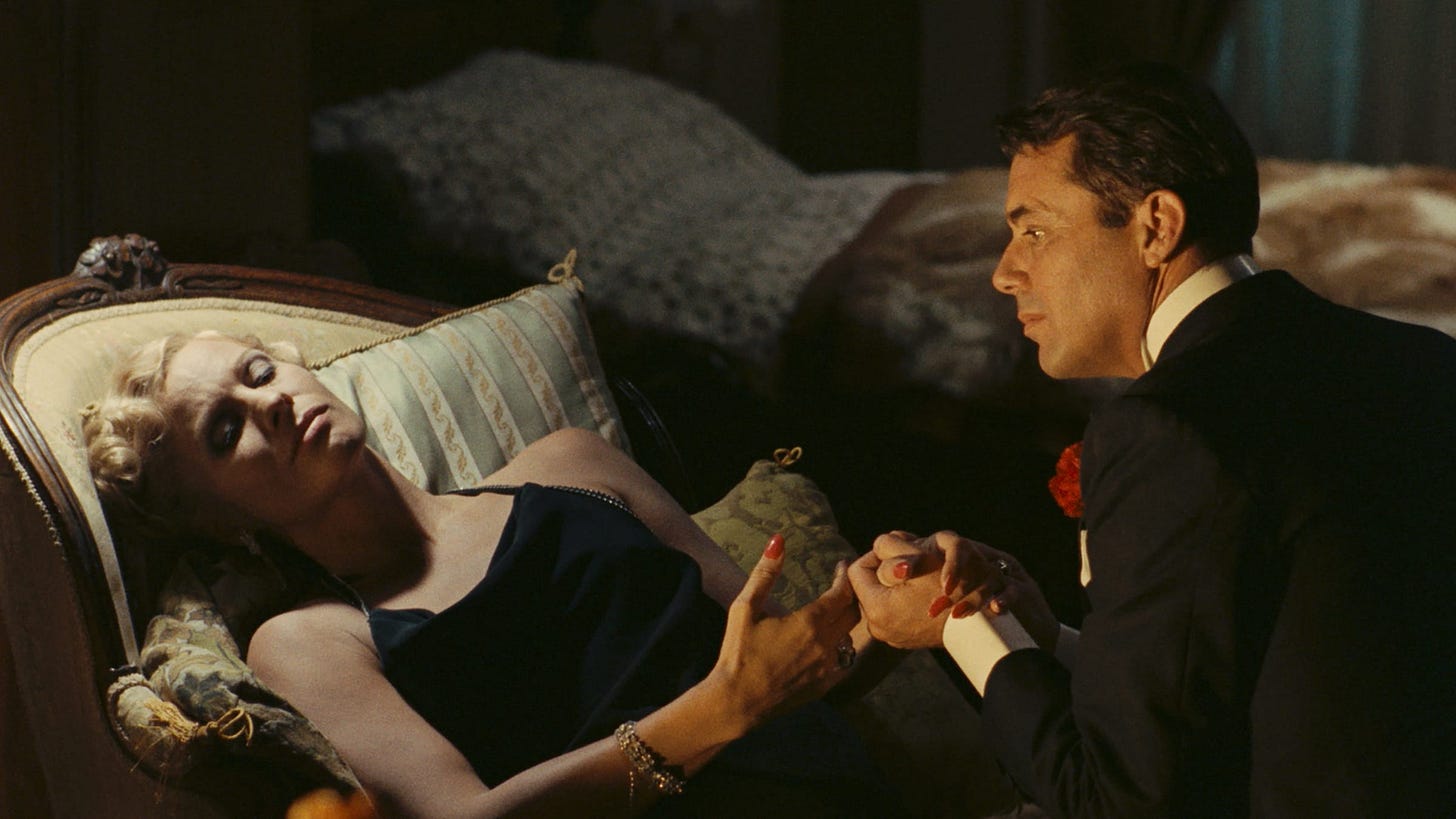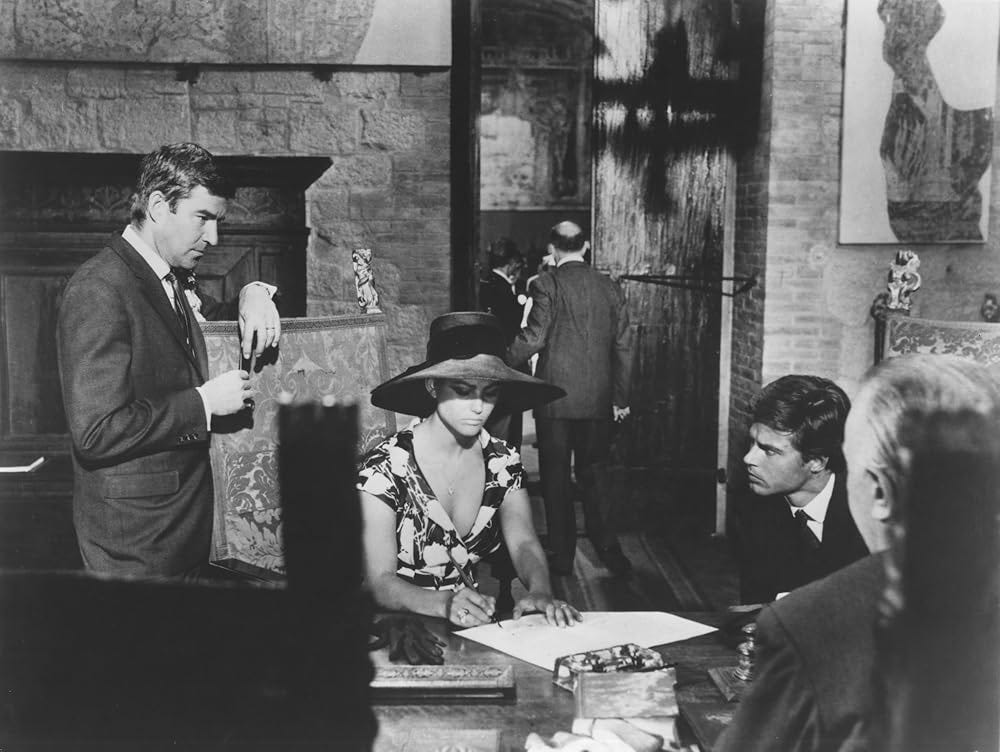"Glimmering stars of the Great Bear, I never thought I'd be back to see you Shining down on my father's garden, Nor talk to you ever again from the windows Of this house where I spent my childhood And saw the last of my happiness vanish" —Giacomo Leopardi
The films of Luchino Visconti fluctuate between major historical epics of decomposition and so-called minor films, the latter of which usually come in the form of literary adaptations of renowned authors such as Fyodor Dostoevsky (White Nights), Albert Camus (The Stranger), and James M. Cain (Obsession). This is where 1965’s Vaghe stelle dell’Orsa (or Sandra in English), the follow-up to his widely acclaimed masterpiece The Leopard, initially stands out as a comparatively original creation, loosely inspired by the Greek myth of Orestes.
Claudia Cardinale plays the titular Sandra, a young woman returning to her family estate, accompanied by husband Andrew (Michael Craig), for a commemorative celebration of her deceased father, who died in a concentration camp during World War II. It’s a death her now mentally incapacitated and hospitalized mother is assumed to be responsible for, having betrayed Sandra’s father with her lover and now guardian Antonio (Renzo Ricci). Her brother Gianni (Jean Sorel) still resides at the estate and is the family member closest to Sandra; the two share a special bond that comes to drive the film, as it is through him she returns to the past, a complex, destructive past that belies the simple formalities of the ceremony.
Unlike most of Visconti’s films that thematize the past, Sandra is set in the present, namely Boom, Italy, an important factor as two worlds ever so briefly meet and consistently clash: first, in the punctuations between classical, The Leopard and Senso-adjacent, piano and modern pop, but also during the opening credits, which see Sandra, in her sports car, pass numerous Coca Cola billboards en route to the estate, all while the same piano music dominates. Such moments may appear superficial initially, but portend much of the later conflict and solidify Sandra as a person between worlds, anticipating the choice her future self will have to make, something she herself seems aware of, when one considers her distressed expression near the end of the opening sequence.
The film was fittingly shot by Armando Nannuzzi — his first time shooting for Visconti — one of the leading cinematographers of boom aesthetics during the 1960s and a frequent collaborator of Mauro Bolognini (The Big Night, Il bell’Antonio) and Antonio Pietrangeli (Adua and Her Friends, The Girl from Parma), two of the forerunners of depicting modern alienation through modern means. After Sandra, Nannuzzi would become a frequent collaborator of Visconti’s, shooting both The Damned and Ludwig with him.
As with Visconti’s epics, the weight of the past also dictates this film, its inconclusiveness and opacity complicating any straightforward reading. As the film progresses into the first night and the two’s first encounter, it becomes clear that both Gianni and Sandra evidently love each other and that said love grew out of some past event and yet their perceptions couldn’t be more diametrically opposed. For Sandra, her mother is the interpretation’s fulcrum, for her betrayal of the family and her virulent anti-semitism that enabled it — emblematized in her vitriolic remarks about Sandra’s “rottenness” — bonds her, in what film scholar Geoffrey Nowell-Smith calls “racial solidarity,” to Gianni, who, in turn, experiences pure passion; for him, the myth and uncertainty of the past rule and finds themselves romanticized in his maudlin behavior.
Between them stands Andrew, irrevocably in the middle, yet unavoidably detached from the avowed traditions at hand. He represents a cold rationality that counteracts Gianni’s sentimentalism — this gulf between them is literalized in their first interaction, in which Gianni remains stoic and vague, while Andrew demands answers — and can only offer Sandra a way out of what Joe McElhaney describes as the “potentially irrational power of the ancient world” which emanates from their family history, and correspondingly Gianni, who remains its greatest heir. In this, to further quote McElhaney, “confrontation with an old Etruscan riddle that cannot be answered,” reconciliation, therefore, remains impossible.
It is here where the influence of Orestes, as well as the aforementioned split between modernity and tradition, flares up. Thus, to extricate herself from the “Etruscan riddle,” meaning Gianni, her past, and her solidarity with him, Sandra also has to reject the family as a whole. Here, Visconti is entirely in line with the general thesis of post-war Italian cinema: the incompatibility of tradition and progress, a utopian, Ritter-School ideal riposted directly back to the wasteland where it spawned from. It, therefore, is far from surprising to see Sandra, arriving at her father’s grave, draped in a perfectly white scarf that seems to signal nothing but the final completion of her “purification.”
To briefly return to Nannuzzi: it is with him at the helm that Visconti finds a new mobility: a frequent occurrence in the film sees sequences commence in deep-focus, medium-wide shots, as was typical of Visconti, before being interrupted by zoom-ins — a technique already inaugurated by Rossellini during his early ‘60s period, here used for the first time by Visconti — which compress, if not occasionally unsettle Visconti’s cinematic space that had hitherto thrived off of its languor. The result is a familiar setting, in this case, a nigh-aristocratic estate, seen through new, piercing eyes. To counteract the natural coldness of Nannuzzi’s deep focus, Gianni and Sandra’s embraces are shot up close, an intimacy always juxtaposed against the static, spacious wide shots of the estate.
One notable example is the dinner sequence during the third act. Just before the guests, including the traitorous Antonio, enter, Gianni and Sandra share a brief moment together, all shot in a tight, warm medium close-up. But just as Andrew and the guests intrude, the camera quickly pans and zooms out into a wide shot of the estate’s vestibule; a shot as cold and formal as the relationship between Sandra and her stepfather. Here, the wide shot takes on a meaning of alienation and detachment — an indication of the world Sandra is eventually ensconced in.
As a film, Sandra functions as a perfect merger between Visconti’s eternal fluctuations; a smaller scope characteristic of his ostensibly minor films, but still focused, perhaps more than ever, on the relationship between past and present. How it is that a film starring Claudia Cardinale at perhaps her artistic zenith and directed by one of the lauded directors of his time, could fall into such deep obscurity, remains one of cinema’s great mysteries.








